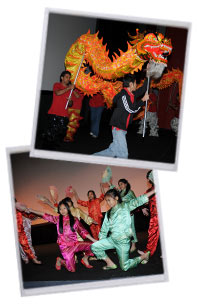“Iron Road is an apology for the mistreatment of Chinese workers who helped build Canada´s railroads”
Santo Domingo,
November 20, 2008
During a break in the activity, members of the Chinese community in the DR performed a
dance of the lion and a dance of the dragons
Charlotte Sullivan, actress in Iron Road, shown Thursday night in the National Theater, calmly and serenely told an audience of more than 150 people including representatives of the Chinese community, that the film “is an apology letter to the people of China for the mistreatment they suffered during the building of the railroads in Canada…it is also a love letter for the whole world.”
Set at the end of the 19th century, Iron Road was directed by David Wu with the participation of well-known film stars such as Oscar-winner Peter O´Toole and Sam Neill of Jurassic Park fame.
 Iron Road tells the story of “Little Tiger,” an intrepid and intelligent 19-year-old who, passing herself off as a man, heads to Canada to get a job building the railroads just as 2,000 other Chinese workers did before her in their search for prosperity and fortune. But their luck would be much different. Work conditions were so difficult that the majority of the laborers died far from their homes, corroborating what the history books say: for every mile of railroad, three workers lost their lives. Iron Road tells the story of “Little Tiger,” an intrepid and intelligent 19-year-old who, passing herself off as a man, heads to Canada to get a job building the railroads just as 2,000 other Chinese workers did before her in their search for prosperity and fortune. But their luck would be much different. Work conditions were so difficult that the majority of the laborers died far from their homes, corroborating what the history books say: for every mile of railroad, three workers lost their lives.
Anne Tait, the film´s producer, told the panel that the film “paints a portrait of a dark period” in Canada´s history during which many Chinese workers died and were mistreated by their bosses and the Canadian government. Ms. Tait said the idea to make a feature film came about coincidentally one night when she was looking through old photographs of the building of the railroads.
In one of the photos she saw a young woman surrounded by men in the hold of a ship. She automatically began to wonder what the young woman was doing there; she continued her musing to imagine the rest of the story.
To the rhythm of the drums and Chinese cymbals, the Chinese community performed the dance of the dragons, a symbol of power, the greatness of the gods and the dance of the Chinese lions, all of which are the guardians of Chinese culture and tradition and whose red, white and black colors symbolize feelings of happiness for the Chinese.
|








